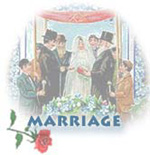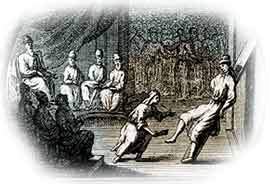|


According to Biblical law,
the brother of a deceased childless man is required to marry his brother's widow.
The levirate marriage is referred to in Hebrew, as yibbum.[1]
When the levir (yavam) does not wish to marry the childless widow (yevamah),
the ceremony of halizah (Heb. lit. removing the shoe) must take place.
This ceremony releases the woman from the levirate tie (zikkat ha-yibbum)
and she is free to marry someone else.[2]
 |
Engraving
for the tractate Yevamot, from a title page of the Hebrew-Latin Mishna.
Illustrated by Mich. Richey, Amsterdam, 1700-04. The tractate deals with
levirate marriage, and the engraving shows the widow holding the "halizah
shoe" which she has removed from her brother-in-law's foot.
(Jewish National and University Library, Jerusalem) |
In the Talmud, the scope
of yibbum is confined to paternal brothers and to cases in which there
is no child of either sex, including an illegitimate child.[3]
Halizah, pulling off the shoe and handing it over, symbolizes an act
of transfer or renunciation, is described in the Book of Ruth: "To make
any transaction valid… the ancient custom in Israel was that one party
would take off his sandal and give it to the other; this was how exchanges were
attested to in Israel."[4]
The purpose of levirate
marriage was to obviate what was regarded as a great calamity —
the danger that a man's family line might become extinct and his property passed
on to heirs who were not his descendants. Though the duty of marrying a brother's
childless widow was not enforced, the refusal to do so was considered disgraceful
in ancient times; the act of halizah was a public demonstration of communal
discredit vis-a-vis the yavam who had refused to "carry on the name of
the dead man in Israel."[5]
With the abolition of polygamy,
levirate marriage has disappeared, and halizah is still the accepted
custom in many traditionally observant Jewish communities. The halitzah
shoe, made from the skin of a clean animal, consists of two pieces sown together
with leather threads; it is usually the property of the community.
MARRIAGE
Table of Contents
|



